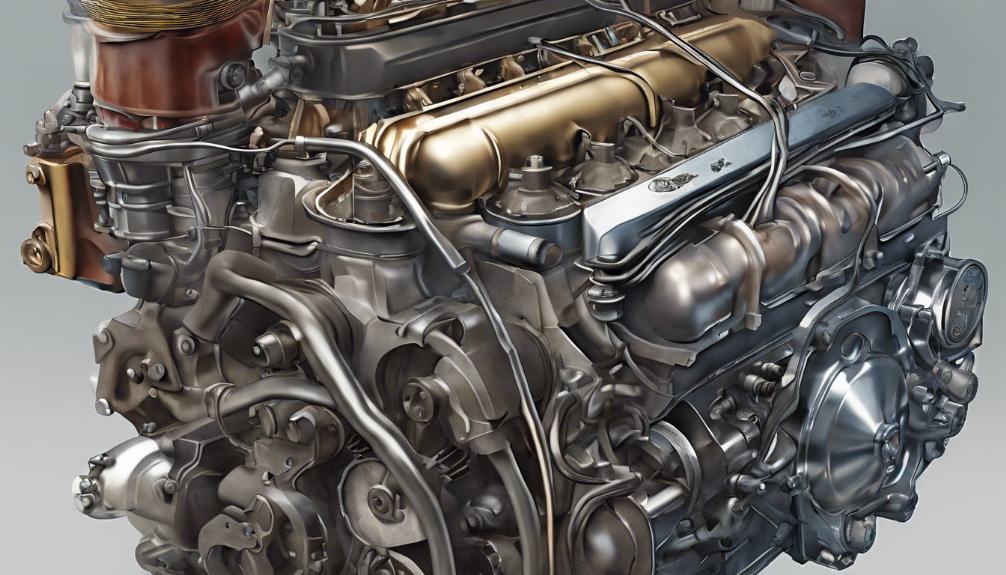When facing the P0026 Code concerning the intake valve control solenoid, it’s important to grasp the range and performance insights for effective issue resolution.
Common symptoms include rough idling, misfires, and decreased fuel efficiency. To diagnose, test the VVL system, check wiring connections, and use OBD-II for solenoid actuation.
Causes may stem from valve neglect, electrical faults, or non-OEM parts. Resolve by maintaining the solenoid, ensuring cleanliness, and promptly addressing valve issues.
Preventative steps involve regular VVT/OCV filter maintenance and prompt troubleshooting of wiring or grounding. Following OEM guidelines is key. Learn more to master managing this code effectively.
Key Points
- Rough idling and engine misfires are common symptoms of P0026 code.
- Diagnostic steps involve testing VVL system and checking wiring connections.
- Inadequate valve maintenance and wiring issues can cause P0026 code.
- Regular solenoid maintenance and cleanliness are crucial for resolving P0026.
- Prevent P0026 by maintaining VVT/OCV filter, using OEM parts, and addressing wiring problems promptly.
Common Symptoms of P0026 Code

Experiencing rough idling or engine misfires are common symptoms associated with the P0026 code.
These issues can lead to idle problems and performance concerns, causing your vehicle to run erratically or even stall.
Alongside these idle issues, you may also notice a decrease in fuel efficiency and power loss.
This means that your car mightn’t accelerate as smoothly as before, and you might feel a loss of overall power when driving.
It’s important to address these symptoms promptly to prevent further damage to your engine and maintain peak performance.
When your vehicle exhibits these signs, it’s essential to take action to diagnose and rectify the P0026 code. Ignoring these symptoms could lead to more severe problems down the line, potentially costing you more in repairs.
By addressing the idle issues, performance concerns, fuel efficiency, and power loss associated with the P0026 code promptly, you can help preserve your vehicle’s overall health and performance.
Diagnostic Steps for P0026 Code
If you notice rough idling or engine misfires due to the P0026 code, the next step involves conducting diagnostic steps to address this issue effectively.
Testing procedures are essential to pinpoint the exact cause of the fault.
Begin by checking the wiring and grounding connections related to the Intake Valve Control Solenoid. Make certain that there are no visible signs of damage or corrosion that could be affecting the solenoid’s performance.
Then, testing the functionality of the Variable Valve Lift (VVL) system is vital in troubleshooting this code.
To further diagnose the problem, consider actuating the solenoid using an OBD-II connection to observe its response. This can help determine if the solenoid is receiving proper signals and functioning correctly.
When performing these troubleshooting techniques, remember to handle components with care to avoid overtorquing parts, which could lead to further issues.
Sensor swapping may also be a useful method to identify if the problem lies within the solenoid itself or other related components.
By following these diagnostic steps diligently, you can effectively address the P0026 code and restore your vehicle’s peak performance.
Potential Causes of P0026 Code

Potential causes of the P0026 code may stem from various issues related to the Intake Valve Control Solenoid‘s range or performance.
One common culprit is inadequate valve maintenance, leading to malfunctions that trigger the P0026 trouble code.
Furthermore, electrical troubleshooting is essential as wiring problems, grounding issues, and VVL valve malfunctions can also be at the root of the P0026 error.
The use of non-OEM parts or sensor swapping can further exacerbate the situation, causing the code to appear.
To diagnose the P0026 code effectively, it’s vital to perform thorough electrical troubleshooting to identify any faults in the system. Regular maintenance of the intake valve control solenoid can help prevent the recurrence of the P0026 code.
How Does Low Engine Coolant Flow Performance Relate to Intake Valve Control Solenoid Range/Performance?
Addressing low coolant flow performance is crucial for maintaining proper engine temperature and overall vehicle performance. When the engine coolant flow is low, it can affect the intake valve control solenoid’s range and performance, leading to potential issues with engine efficiency and emissions control. Regular maintenance and monitoring can help prevent these problems.
Solutions for Resolving P0026 Code
To effectively address the P0026 code, focus on implementing practical solutions for resolving the issue. Begin by prioritizing solenoid maintenance.
Guarantee the intake valve control solenoid is clean, free of debris, and functioning correctly. Regular upkeep can prevent malfunctions that trigger the P0026 code.
Next, consider valve actuation. Test the intake valve’s movement to verify proper functioning. Make sure the valve opens and closes smoothly without any obstructions.
If there are issues with valve actuation, addressing them promptly can help rectify the P0026 code.
Preventative Measures for P0026 Code

Regularly maintaining the VVT/OCV filter is vital in preventing issues related to the P0026 trouble code.
To avoid triggering the P0026 code, make sure you check and replace the VVT/OCV filter at recommended intervals.
Proper installation of the VVT/OCV filter is essential for maintaining top engine performance and preventing malfunctions. Address any wiring or grounding problems promptly to mitigate the risk of encountering the P0026 trouble code.
Using OEM parts and following manufacturer recommendations can greatly reduce the likelihood of P0026 code occurrence.
When in doubt, seek professional guidance for preventive maintenance measures against the P0026 code.
As an Amazon Associate we earn from qualifying purchases.










